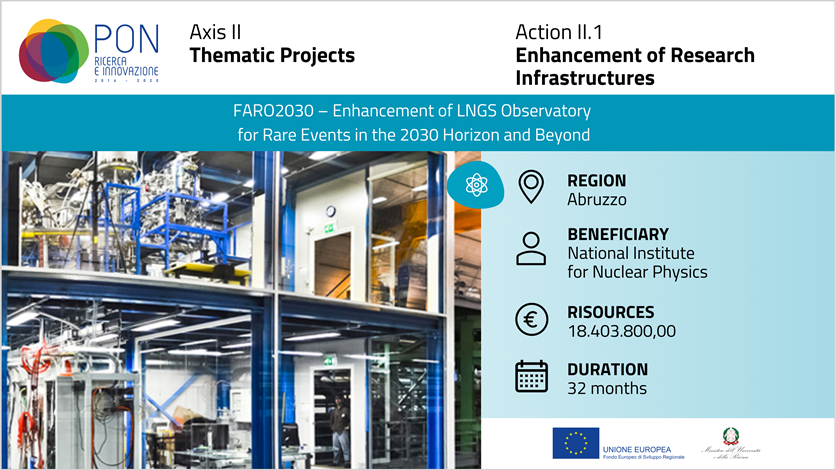Notizie correlate
Non ci sono notizie correlate.
FARO2030

ITA | ENG
Project
The Gran Sasso National Laboratory (LNGS) is among the world’s largest and best equipped infrastructures for underground research in astroparticle physics and nuclear astrophysics. The aim of FARO2030 is to provide the facility with the means to continue to host experiments, at the frontiers of physics and in the 2030 horizon and beyond, which will lead to the development of new techniques and methodologies. The project involves the following activities:
- overall upgrading of the technical infrastructure, with the installation of a redundant fibre optic data transmission infrastructure to strengthen the connectivity between underground laboratory and external laboratory, using the L’Aquila-Teramo motorway sector, and installing end-points at locations other than those currently in use;
- expansion of the existing infrastructure by building an ISO 6 clean room at Nuova Officina Assergi (NOA) and increasing the measurement capacity of the STELLA (SubTErranean Low Level Assay) laboratory, thus contributing to the management and assembly of silicon photomultipliers (SiPMs) in the former facility and to the measurement and identification of radioactive contaminants of materials at STELLA, a crucial activity for the selection of radio-pure materials used for the construction of the experiment detectors at LNGS;
- enhancement of the necessary infrastructures for the development of DarkSide-20k, the main international project devoted to the search for Dark Matter carried out at
All the experiments conducted during the FARO2030 project are aimed at studying physical processes that generate very rare events and require high purity building materials with low concentrations of mainly uranium, thorium and potassium.
Financial Resources
The project obtained 18.403.800,00 euro in funding from the NOP Research and Innovation 2014-2020 under the action “Enhancement of Research Infrastructures”, which supports projects aimed at the upgrading of 18 research infrastructures identified as priorities by the Ministry of University and Research in the PNIR 2014-2020, covering one or more ESFRI (European Strategy Forum on Research Infrastructures) areas and having a significant impact on the trajectories of the National Smart Specialization Strategy, in particular in the Areas “Health, Nutrition, Quality of Life”, “Digital Agenda, Smart Communities, Smart Mobility Systems”, and “Aerospace and Defence”.
Impact on the Territory
The beneficiary of the funding is the National Institute for Nuclear Physics, Gran Sasso National Laboratory (near L’Aquila), located alongside the 10 km long A24 motorway tunnel (direction Teramo-L’Aquila), crossing the Gran Sasso mountain. The proposed upgrading, through the NOA, STELLA and DarkSide-20k infrastructures, will enable the LNGS to meet the crucial challenges set out in the European Astroparticle Physics Strategy 2017-2024, developed by the Astroparticle Physics European Consortium (APPEC) and aimed at the search for Dark Matter and neutrino-less double-beta decay. The upgrading will also contribute to the creation of the necessary expertise to meet the needs of new experiments and to open new pathways for possible multidisciplinary applications in each of the fields using the information provided by the measurement of radioisotopes (e.g. radioecology, archaeometry, traceability and monitoring of the geographical origin of food). In particular, the construction of the NOA clean room and its equipment for the manipulation of SiPMs with the future transformation of silicon chips into end products will constitute the missing link between INFN, LFoundry in Avezzano and industry, developing useful tools for medical diagnostics and smart mobility devices.
Further information (in Italian):
26/04/2021








